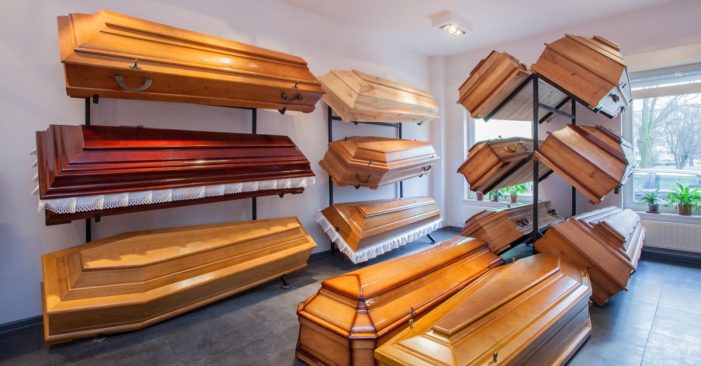By Kimiko de Freytas-Tamura, NY Times
Sharon Escobar couldn’t recognize her father.
His face was so badly decomposed that she and her mother were eventually able to identify him only because of a scar on his leg.
Ms. Escobar had paid a funeral home in Brooklyn to tend to the remains of her father, Elisha Magosha, after he died in mid-April from complications of Covid-19.
Two weeks later she learned that his body had been disintegrating alongside more than a dozen others inside two U-Haul trucks parked in front of the Andrew T. Cleckley Funeral Home, a small building squeezed between a sex shop and a dollar store.
Odors seeping from the trucks were the clues to what was going on at the funeral home on Utica Avenue, prompting passers-by to complain to the authorities.
The discovery in early May, as the pandemic held a firm grip on New York, shocked and angered a traumatized city, and in November, the home’s director, Andrew Cleckley, had his license revoked by the state for improperly handling the remains of pandemic victims.
Mr. Cleckley said he was overwhelmed by the deluge of bodies his home received and said that even though he was the principal leaseholder, five other funeral services operated out of the building, and he could not be responsible for overseeing how all of them were treating remains.
Still, a large part of his job involved embalming bodies for those other firms, raising questions about the extent of his role.
“Everything I did was out of compassion — helping the other funeral homes, embalming their bodies, picking up bodies for them,” he said, as he stood in a visitation room on the second floor of his now-closed funeral home.
“People were calling, ‘Come get my mother, please. I can’t find a funeral home,’’’ Mr. Cleckley added. “It was just hard times.”
While the case attracted widespread attention in the spring, an examination by The New York Times revealed how extreme conditions had become. Mr. Cleckley continued to accept bodies even though he could not keep up with the mounting caseload and never sought outside help to lessen the burden. As a result, dozens of decomposing bodies were scattered haphazardly throughout the home and some families were unable to locate their relatives’ bodies.
What unfolded at the Cleckley home was perhaps the most extreme episode that emerged when the pandemic engulfed the city’s system for handling the dead — reflecting the tragedy, chaos and overall lack of resources in the face of the biggest public health crisis in a century.
“It was the craziest time I’ve ever been alive,” said John D’Arienzo, president of the Metropolitan Funeral Directors Association. “After Mr. Cleckley’s actions came to light, the medical examiner realized how overwhelmed funeral services were.’’
Other funeral homes were also forced to find spaces for bodies wherever they could, in chapels or visitation rooms, raising the air conditioning to prevent decomposition. They had to send bodies to other cities or out of state to have them cremated.
“Everyone wanted to use the crematories, but there was no space available,” said David Penepent, the director of the funeral services administration program at SUNY Canton, who created a service that helped transport bodies to crematories far from the city. “So that’s how the problem developed.”
Dr. Penepent was asked by New York City’s office of emergency management to help catalog and transport 63 remains from the Cleckley funeral home, including those stored in the trucks, to a makeshift morgue on the Brooklyn waterfront. He arrived at the home on May 1.
Even as a 27-year veteran of the funeral home industry, he was disturbed by what he found. Bodies inside the trucks were “stacked like cords of firewood.” In the visitation room, unwrapped remains that had not been embalmed were piled haphazardly, including a 250-pound man on top of a 185-pound woman. The smell was nauseating.
“It was horrifying, the most horrifying disrespect for human remains,” Dr. Penepent said in an interview.
Despite worsening conditions at his funeral home, Mr. Cleckley continued to accept bodies for embalmings and viewings, according to a state Health Department report obtained by The Times after a Freedom of Information request.
“Some human remains were at advanced stages of decomposition and putrefaction, having been there for an extended period of time of greater than four weeks,” according to the report, which recommended that Mr. Cleckley’s license be taken away and that he be fined $68,000.
Bodies were found lying “willy-nilly across a chapel floor, completely exposed or partially wrapped in sheets with stains of body fluids,” the report said, adding that Mr. Cleckley failed to take appropriate measures to prevent decay, like using formaldehyde, leaving remains vulnerable to maggots.
“He should have focused on the human remains scattered around his funeral home and preparations needed to connect them with loved ones,” the report said. “Instead, these bodies became victims of his neglect while he substantially increased his caseload by continuing to take in more trade work.”
But Mr. Cleckley’s lawyer argued that the state failed to prove its case against his client.
“There was not an ounce of testimony that a human remain entrusted to Mr. Cleckley was not treated with dignity and respect,’’ the lawyer, Robert Osuna, wrote in a brief submitted to the state, adding that Mr. Cleckley had an “unblemished record and never before had been the subject of a complaint.”
Mr. Cleckley was being unfairly punished for the actions of other funeral services that operated out of the home, Mr. Osuna said.
“I think he was scapegoated for the entire pandemic and the funeral industry in New York,” he said in an interview.
Mr. Magosha’s family said another funeral director at the Cleckley home, Anthony J. Armstead, sent an email claiming that he had embalmed Mr. Magosha’s remains when, in fact, the body was lying in the U-Haul truck. They have sued Mr. Armstead in addition to Mr. Cleckley.
In a brief interview, Mr. Armstead declined to discuss the case. “I did not have anything to do with anything,” he said.
Other families who hired the home to care for the remains of their dead relatives described shoddy practices that deepened their trauma.
Relatives of Hermite Mercius, who died on April 18 in a Brooklyn nursing home from the virus, said the funeral home misidentified her remains, sending them a photo of someone who was not her.
“It was a completely different person,” said Ms. Mercius’s sister, Antonine Beaulieu.
When Ms. Beaulieu tried pressing the funeral home for details, “I couldn’t get in touch with anybody,” she said. “The city called me two weeks later to tell me they had the body of my sister, and they sent us a real picture of her. So I had to ask a different funeral home to go get her body.”
Mr. Cleckley is named in six lawsuits filed by relatives of six people, accusing him of improperly handling their remains.
A native of Queens, Mr. Cleckley, 41, said he was trained at the American Academy McAllister Institute, a funeral services school in Manhattan, and graduated from Nassau Community College. He opened his funeral home in February 2018.
Mr. Cleckley said he entered the funeral business after becoming fascinated with the art and science of embalming when he started doing odd jobs for a funeral director who attended his mother’s church.
“One weekend I was told to take some clothes downstairs so the embalmer could dress a body,’’ he said. “I observed what he was doing, and I made my decision right there, that that’s what I wanted to do. I fought hard to become a funeral director.”
Before the pandemic, Mr. Cleckley said he averaged between six and seven funerals every month. But by the end of February, he had already performed 20 services.
At the beginning of April, he said his phones started ringing incessantly.
“Every time I hang up with a line, my line rings back,” he said. “I took 10 calls in one day.”
Then it became 20. He started calling New York City’s five crematories, but he said they turned him away because they were full. He finally found two in New Jersey, one in Newark and another in Camden, but they only had room for a limited number of bodies.
So on April 12, he said he rented a refrigerated truck because he could not keep up with the bodies that were being taken to his funeral home.
“Things were happening so fast,” he said. “I’m in the back, I embalm five bodies. Then I got to run out and pick up two or three bodies. I’ve got to embalm those or put them on the refrigerated truck. Then I come back, and I’m told ‘Oh, these people called.’ I couldn’t attend to everybody else because I was so busy.”
One of the bodies he took care of was that of a cousin who died of the virus. “I did it because of my professional training,” he said. “But it wasn’t easy.”
On April 25, he rented a regular U-Haul truck because he said truck companies had stopped renting refrigerated vehicles to funeral homes. He used that U-Haul three times, he said, to transport bodies to the crematories in New Jersey.
Of the 63 bodies that were retrieved from the funeral home, Mr. Cleckley said only 15 of them were under his care, while the rest were the obligation of the other funeral directors working at his building.
But the state said Mr. Cleckely bore ultimate liability for what occurred because his name was on the lease and that he did not provide evidence linking the other funeral directors to any of the bodies.
“If your name is on the front of the building, whoever was doing illegal acts or immoral acts, you’re the responsible party,” Dr. Penepent said, adding that Mr. Cleckley never asked for help.
Mr. Cleckley is now out of a job and has been cleaning out his funeral home. He has also gotten a fresh tattoo on his neck — a devil whispering in his ear.
A number of other lawsuits have recently been filed against other funeral homes in New York City and New Jersey. In one case, a funeral home cremated the wrong remains. In another, a body was sent to Hart Island — New York’s potter’s field — to be buried without the family’s knowledge or approval.
“I think we were all a little sloppy in the beginning,” said Pat Marmo, an unusually frank funeral director in Sunset Park, Brooklyn, who said it was difficult to keep remains properly cold when there was no space in refrigerated storage rooms.
“They were all categorized, stacked properly, but there was one problem: I had an odor,’’ he said. “No matter how much air conditioning I put on, it wasn’t a refrigerated room. Nobody was trained for this. Nobody.”
For some families who sought Mr. Cleckley’s services, what happened to their relatives’ remains was inexcusable.
Mr. Magosha, 59, a retired diplomat and a former officer in the Zimbabwean Army, died on April 15, days after being hospitalized with chest pains.
“I honestly did not think he was going to pass,” said Ms. Escobar, his daughter, breaking down in tears. “I thought he was going to be able to fight through it and he was going to come back home.
“My last word to him was walking out and saying, ‘I love you,’’ she added. “And that was it.”
Ms. Escobar and her family had to pay to have her father’s face reconstructed. His body was flown to Harare, fulfilling his wish to be buried in his homeland.
“I’m still in disbelief,’’ she said, “just still in disbelief.”


